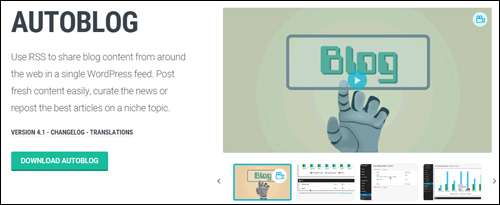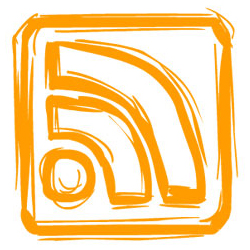 No matter what what industry you belong to, providing high-value information to your blog visitors is important. For example, if you provide medical services, you may want to include the latest information from the health department, such as news and updates on medical research, health and fitness advice, etc.
No matter what what industry you belong to, providing high-value information to your blog visitors is important. For example, if you provide medical services, you may want to include the latest information from the health department, such as news and updates on medical research, health and fitness advice, etc.
To create and publish this kind of information, however, involves an enormous amount of effort and resources. You have to sort through, gather, and organize a lot of information, check your facts, write and edit content (or hire someone to do this for you), and then continually ensure that this information is kept up-to-date. As you can imagine, this not only involves a huge amount of work but most of the information you are dealing with is well beyond your control.
Fortunately, there is an easier way to continually provide your readers with expert, up-to-date information.
It’s called RSS …
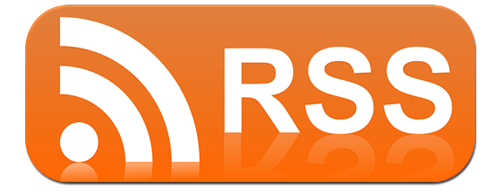
(RSS - The easiest way to provide your site readers with great information)
The Ultimate Guide To WordPress RSS
What You Need To Know About RSS
- RSS, which, according to some experts is short for RDF Site Summary, is more commonly referred to now as Really Simple Syndication. It is often referred to as a “feed” or “web feed”.
- Once a user subscribes to an RSS feed, they no longer have to physically check the website for updated content. Instead, their web browser will constantly monitor the site and automatically keep subscribers updated.
- RSS feeds are often used to publish information that is frequently updated, such as new blog entries, news, audio lists, etc., which any user can choose to subscribe to.
- Essentially, an RSS feed is a structured XML document that includes either full or summarized text along with metadata such as date of publishing, feed author, etc. It allows people to subscribe to content on sites that publish feeds and then keep up with any updates posted on these websites using an RSS feed reader. Conversely, RSS feeds also enable publishers to syndicate content automatically.
- Feeds can be made available in different types and read by different feed aggregators. Some of these include RSS feeds, Atom Publishing Protocol) feeds and RDF feeds. All of these formats, however, use a standard XML file format to ensure compatibility with different devices and programs.
- Many sites and software applications also allow you to combine multiple RSS feeds to receive news and updates from several different sources.
This guide explains where your RSS feed is located, how to use your WordPress RSS feed to get your content syndicated online, and how to add content from other websites and blogs to your site via RSS.
RSS (Really Simple Syndication) Feeds
Content syndication is a very powerful (and legitimate) method used for sharing web content. RSS Feeds provide web users with a simple and easy way to keep up with the latest information posted on sites they are interested in.
First, let’s take a look at content syndication.
Most online newspapers use syndication to publish content from news sources all around the world.
Content syndication allows online newspapers and many popular media publications to deliver readers up-to-the-minute news headlines and newsworthy stories from all around the globe without actually having to hire and post additional news reporting agencies to every place around the world …
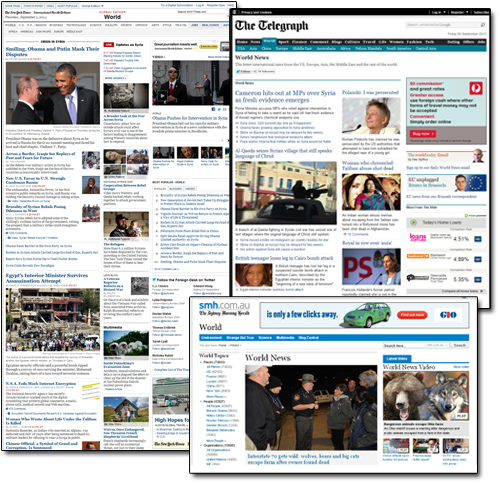
(Media publications rely on content syndication to publish newsworthy items from news sources around the world.)
Syndication is a legitimate method of sharing information. Content agencies syndicate their newsworthy content using feeds …
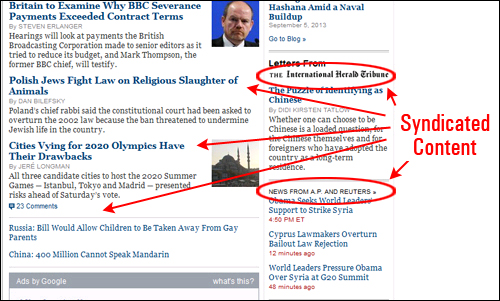
(Content syndication is used by news reporting agencies to share information with other publications)
Most sites actually would like you to syndicate their information. Syndicating content not only allows information to be shared, but it can also drive visitors back to the original site responsible for publishing the content being syndicated. This provides websites with new opportunities to generate additional web traffic.
Many news reporting agencies and major content sites include a feed section (look for menu links that say ”RSS”, “Syndication”, or “Newsfeeds” in them, or just search for “name of site/keyword + rss” – e.g. “nytimes rss”, “courier mail rss”, “sydney morning herald rss”, etc.) …
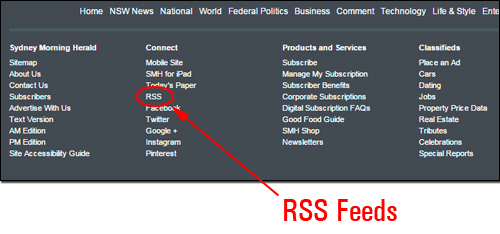
(Many news agencies have a feed section. Source: smh.com.au )
Clicking on a site’s RSS feeds section brings up a list of RSS feeds for different content topics on the site …
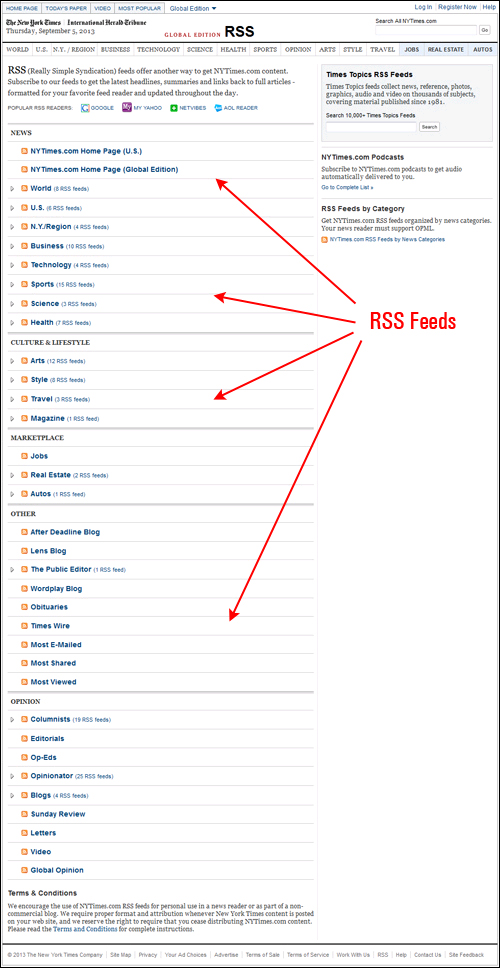
(RSS feeds list. Source: nytimes.com RSS feeds)
gives you access to information from different areas of the website (e.g. business news, sports news, lifestyle magazine, etc.)
Feed sections can also include further feed subcategories …
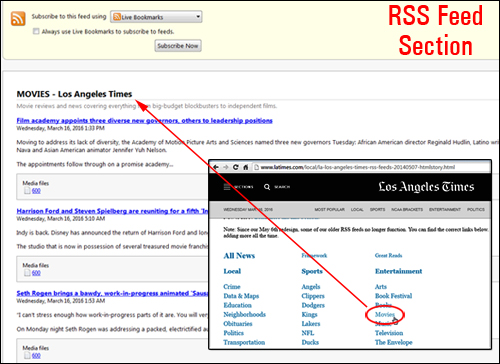
(An RSS list can also contain feed subdirectories. Image Source: latimes.com)
![]()
Note: An RSS feed is only a URL. All you have to do to use a feed is copy the URL and paste it into an application that can process the feed code into something readable. We’ll cover this further below.
The Benefits Of Syndicating Content
Adding content from someone else’s website or blog on your website has some obvious benefits. It not only gives someone else’s website additional exposure online, it also helps you by freeing you up from having to create this content …
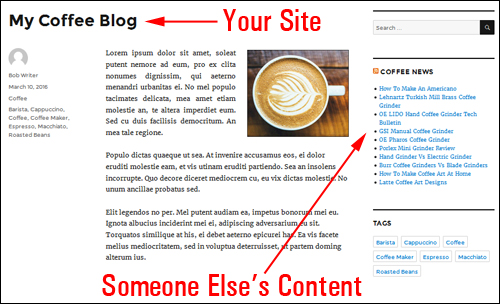
(The Benefits Of Using RSS Feeds)
While adding RSS feeds from another site is a great way to add content to your site that you don’t have to create, it’s worth keeping in mind that you also want other sites to use YOUR content.
When other sites syndicate your content, you have the opportunity to gain increased exposure online and drive more visitors …
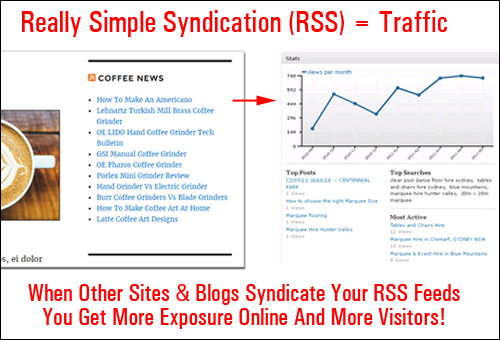
(Get users to syndicate your feed … it will help drive more traffic to your site!)
WordPress RSS – About
By default, WordPress automatically publishes a feed of your latest posts, allowing others to syndicate your content on their sites.
Depending on which theme you have installed, there are a number of ways to access your WordPress RSS feed:
1) If your theme displays the Meta widget on your sidebar or footer menu …
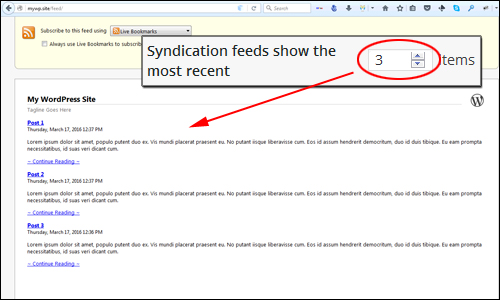
(The feed page will display as many recent items you have specified in your WP Reading Settings section)
Display Full Text Or Summary Of Posts In Your RSS Feed
The other setting in the WP Reading Settings section that affects your RSS feed is whether to display articles in the feed as full text, or a summary …

(Reading Settings – Display ‘Full Text’ or ‘Summary’ for articles in a feed)
![]()
Post Excerpts can also affect how the content in your feed displays …
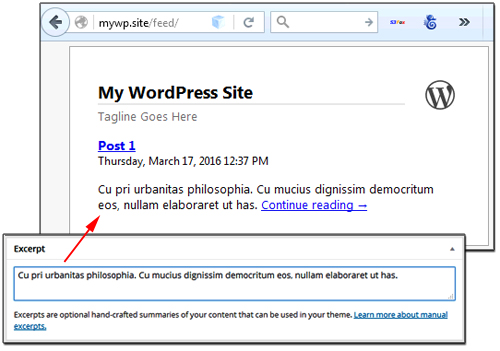
(Post excerpts affect how your feed content will display)
To learn more about WordPress Post excerpts, refer to this step-by-step tutorial:
View The Content Of Your RSS Feeds
As mentioned previously, to view a feed’s content, you have to copy the feed’s URL and paste it into an application that can translate feeds into readable content.
Let’s take a look at how this works.
First, go to a website whose feed you want to syndicate and search for a ‘subscribe’ button or link …
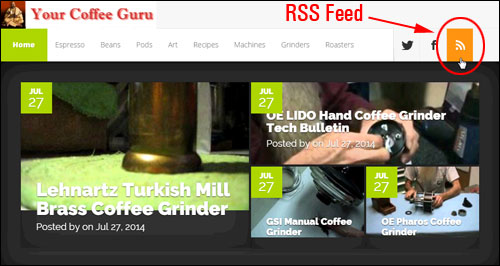
(Look for an RSS feed icon. Image source: YourCoffeeGuru.com)
Next, copy the feed URL to your clipboard …
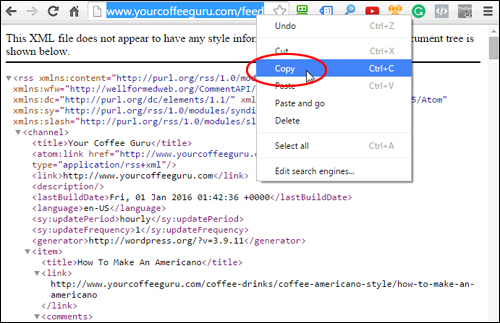
(Copy the URL of your feed to your clipboard)
If you want, you can check what the RSS feed contains by pasting the feed URL into an online feedreader …
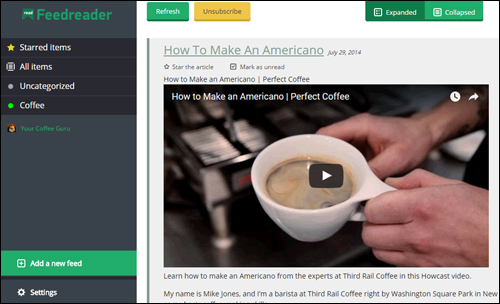
(Paste your feed URL into a feedreader to view the content. Source: Feedreader)
Like feed readers, WordPress has the ability to process RSS/XML feeds.
Adding An RSS Feed To Your WP Site
In the example below, we’ll add content from another website to your WordPress site.
Adding Feeds To Your Sidebar
As mentioned earlier, no matter what industry you are in, you can easily add to your site the latest news and updates from an industry-related government department or authoritative site in your industry simply by adding their RSS feed. You can easily display a range of information on your WordPress site such as news, social media updates, or content from thousands of sites using the WordPress RSS widget.
Let’s add RSS content to your sidebar …
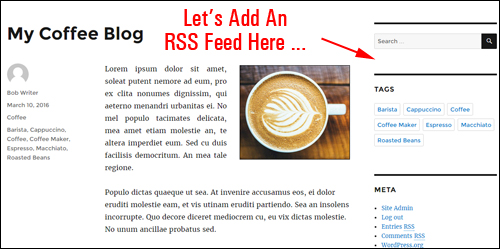
(Let’s add content from an RSS feed to the WordPress sidebar navigation menu)
First, find a website containing content that you want to add to your site and copy its RSS feed …

(Copy the feed URL to the clipboard)
Next, go to Appearance > Widgets and paste the feed into a new RSS widget …
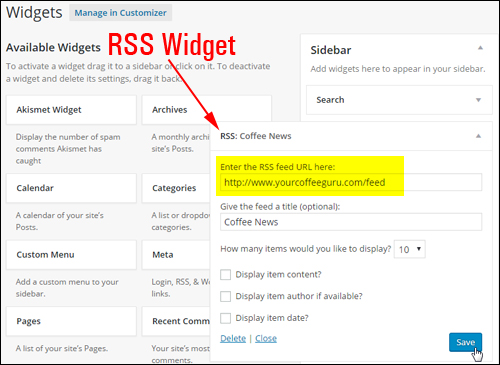
(Widgets Section – RSS Widget)
To learn more about using widgets, go here:
Refresh your web browser. The content from the RSS feed will now appear in the sidebar …
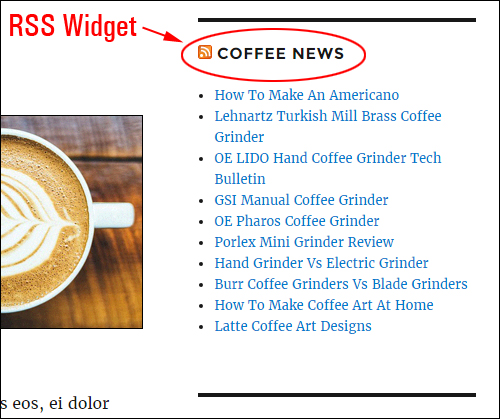
(RSS Widget)
Add Your WordPress RSS Feed To Search Consoles
You can add your WordPress RSS feed to Google and Bing’s search consoles. This will help them index your content faster.
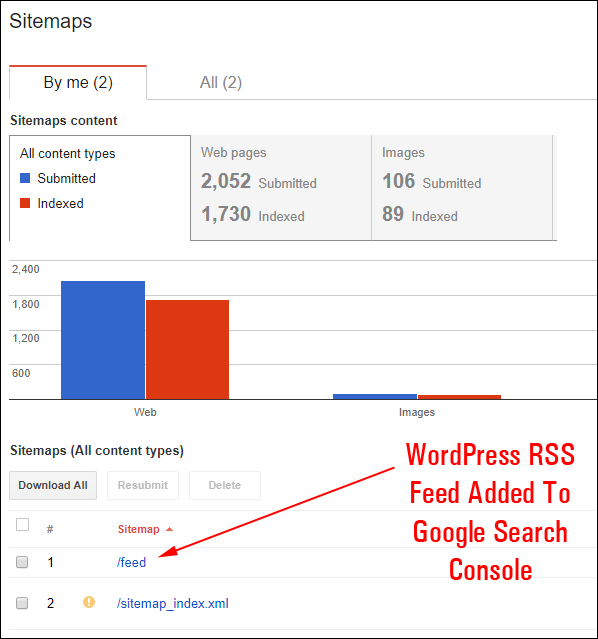
(WordPress RSS feed added to Google Search Console)
Adding your site’s RSS feed to search consoles is simple, fast, easy, and requires no technical skills. For a step-by-step tutorial, go here:
Adding Content From RSS Feeds To Your Posts
Can you add content from an RSS feed to a post? You sure can!
You can easily do this using plugins. Just search inside your ’Add Plugins’ section (Plugins > Add New) for RSS, RSS feed to post, etc.
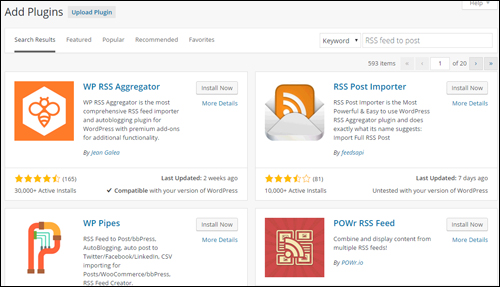
(WordPress RSS plugins)
Note: Most RSS plugins typically require configuration – visit the plugin sites for complete instructions, or contact us if you need assistance configuring plugins.
The plugins below can be used to feed content to posts, or “autoblog” (An autoblog is a blog with content that is automatically gathered and compiled from RSS feeds):
WPeMatico
(WPeMatico WordPress Plugin)
WPeMatico is an auto blogging plugin that allows you to publish posts automatically from RSS/Atom feeds that you specify.
You can manage all the feeds you import and organize feeds into categories.
For more details, go here:
WP RSS Aggregator
(WP RSS Aggregator Plugin)
WP RSS Aggregator is an RSS feed importer and auto blogging plugin for WordPress that offers a number of premium add-ons for additional functionality.
For example, the Feed to Post add-on allows you to autoblog by importing RSS feeds directly into WP posts.
For more details, go here:
RSS Post Importer
(RSS Post Importer Plugin)
RSS Post Importer allows you to syndicate, import, curate, merge and display full-text feeds on your WordPress site.
RSS Post Importer fetches an RSS feed and publishes the entire content of each feed item as a standalone post.
For more details, go here:
Powr RSS Feed
(Powr RSS Feed WP Plugin)
POWr RSS lets you combine and display content from various RSS feeds.
The plugin also lets you display images, videos, and article content, adjust feed size and spacing, use custom backgrounds, colors, fonts, and more. It also displays feeds correctly on all computers, phones, and tablets and supports text in any language.
The premium edition of POWr contains many additional features.
For more details, go here:
WP Pipes
(WP Pipes Plugin)
The WP Pipes plugin is a powerful data migration plugin that lets you create curate content from RSS feeds, Google News, and other sources.
This plugin provides loads of features like CSV importing for posts/WooCommerce, RSS feed creator, auto blogging, auto post to Facebook/Twitter/LinkedIn, export WordPress posts as podcasts, create Google XML sitemaps, and help take your WordPress CMS to new levels.
For more details, go here:
FeedWordPress
(FeedWordPress – WordPress Plugin)
FeedWordPress provides flexible syndication for WordPress content.
As stated in the FeedWordPress site …
FeedWordPress is an open-source Atom/RSS aggregator for the WordPress blog publishing platform. You set up feeds that you choose, and FeedWordPress syndicates posts from those sources into your WordPress posts table, where they can be displayed by your WordPress templates like any other post — but with additional meta-data, so that your templates can properly attribute the post to the source it came from.
FeedWordPress can be used to create aggregator sites, or display all of your online activity into a Lifestream.
For more details, go here:
Autoblog by WPMUDev
(Autoblog WordPress Plugin)
Autoblog is an easy-to-use plugin that can be set-up very quickly, without coding skills or complicated instructions. Just copy and paste in your feed URL, name your feed (for admin purposes) and select the blog that you want it to post to.
For more details, go here:
RSS Includes Pages and Custom Post Types
(RSS Includes Pages WordPress Plugin)
By default, WordPress only posts posts in your RSS feed. Install RSS Includes Pages and Custom Post Types to include pages in your RSS feed in addition to posts.
For more details, go here:
![]()
WordPress RSS – Useful Tips
Tip #1 – Comment RSS Feeds
WordPress displays RSS feeds of your latest post comments in addition to giving online users access to RSS feeds of your latest posts.
To view these, go to the ‘Meta’ widget area on your sidebar (note: your theme may not be configured to display this widget) and click on Comments RSS …
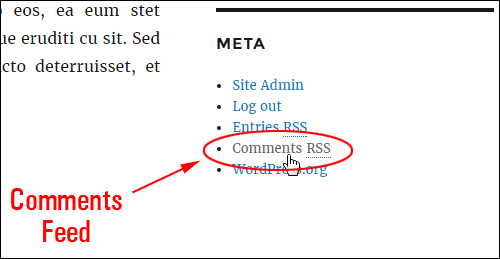
(WordPress Comments RSS)
All the comments posted on your site by visitors and users can be seen in your Comments RSS page …
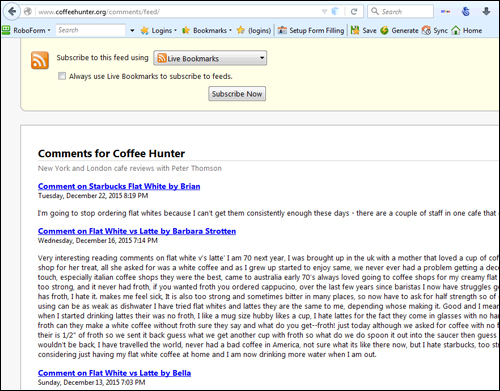
(Comments feed items as seen with a Firefox browser)
Like post entries, your comments feed page will display differently depending on which web browser you are using …
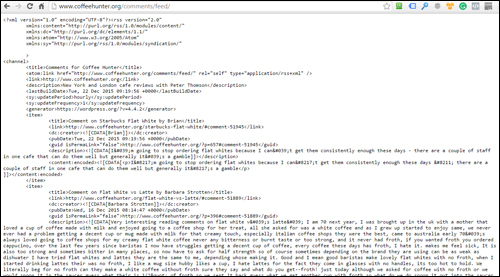
(RSS comments feed items viewed with a Google Chrome browser)
Again, you can check the feed content by pasting the URL of the feed into a feed reader …
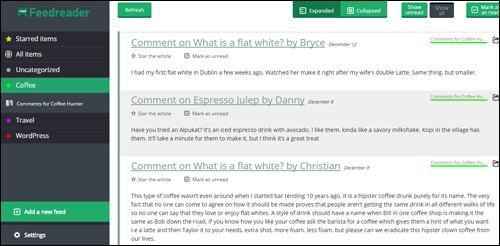
(Paste the URL of your comments feed into a feed reader to view the feed content. Image Source: http://feedreader.com/online)
Note: If the Meta section is not displaying on your theme, you can view the Comments RSS section of your site by opening up a browser and typing in the following URL:
- http://www.yourdomain.com/comments/feed
- http://www.yourdomain.com/blog/comments/feed (if your WP installation is in a subfolder, e.g. “blog”)
Tip #2 – Creating Individual Post RSS Feeds
Being able to create an RSS feed for individual posts can be useful. For example, you may want to add feeds from specific items to RSS aggregator sites, or you may have created a valuable resource that other online users will want to syndicate.
The formula for making an RSS feed for a single post is shown below:

(Specific Post RSS Feed)
To create the above feed, copy the URL of your post, and append “/feed/?withoutcomments=1” to the end.
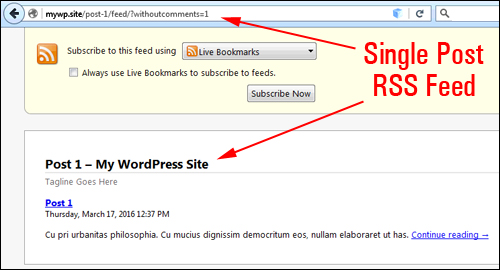
(Single Post RSS Feed)
Note: By default, if you only append “/feed” to the end of your post URI, WordPress will return the comments made on your post, not the content of the post itself.
Tip #3 – Post Category RSS Feeds
Some your site visitors may only be interested in syndicating content from one or two categories. They may not want to subscribe to all of your site’s content.
If you publish content under many categories, you can provide a separate feed for each post category.
Just use the format below:

(Use this format for WordPress post categories RSS feed)
Copy the category URL …
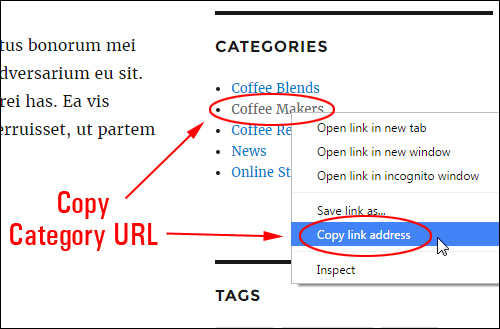
(Select and copy your category URL …)
Append the word “feed” to the end of it …

(RSS feed format for post categories)
Your feed will now only include content posted in this particular category …
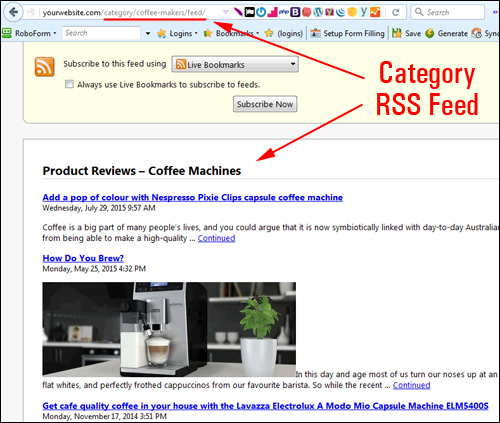
(Category-specific feed)
The WordPress Codex also provides different ways to create feeds not just for post categories, but also feeds for tags, authors, search, etc.
For this example, let’s create a feed for a specific post category using the format shown below:

(Post Category feed format. Source: WordPress Codex)
Here is the feed format WordPress recommends using. In this example, the post category ID is ’42’. We’ll need to replace the post category ID and the domain name …

(WordPress post category feed format)
To find the post category ID, go to Posts > Categories …
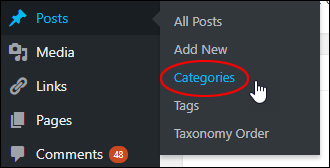
(Posts > Categories menu)
Locate the post category you want and hover your mouse over the title to reveal its unique ID …

(Post Category ID)
In our example, the post category ID is ’29’ and the post category feed format we need to use for this specific category with our domain name looks like this …

(Post category feed format with domain name and ID)
Copy and paste the feed into your browser and hit enter …
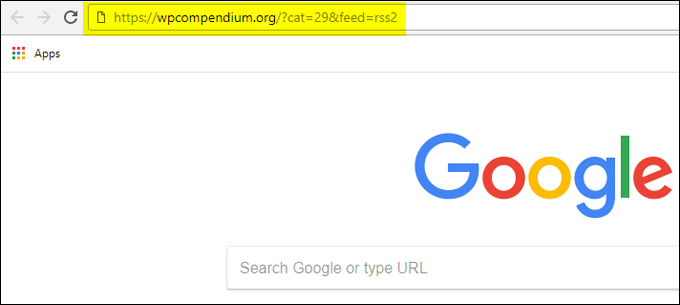
(Paste the feed into your browser)
This will display the feed for that specific category …
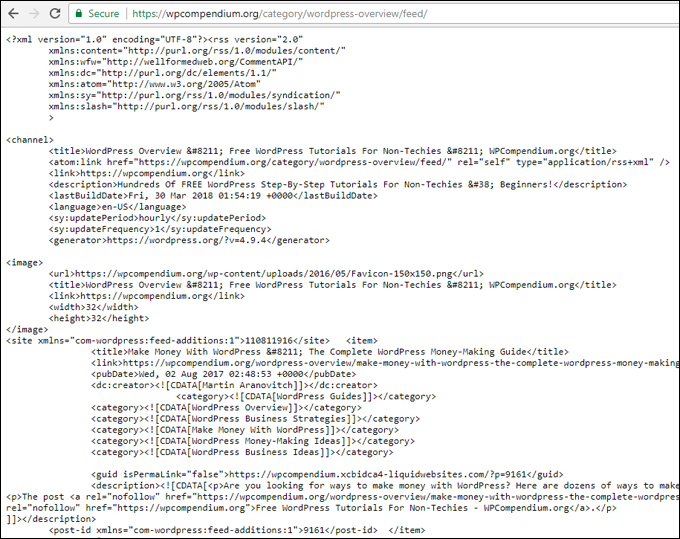
(RSS feed of a specific post category)
Note that in this example, WordPress automatically converted the feed format we pasted into the browser into the category feed we had used in the previous section of this tutorial …

(Post category feed format)
Here is the feed format again …

(Post category feed)
In this case, the simplest way to create additional feeds for specific categories is to simply change the post category slug …

(Change the post category slug to create a new category specific feed)
Paste the edited feed into your web browser and hit enter to display the content for that specific category’s feed …
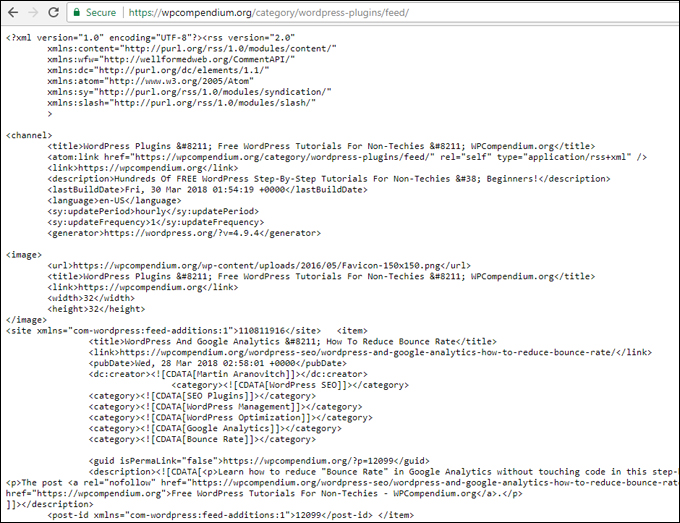
(Post category feed content)
Now that you have a method for creating feeds for specific post categories (or tags, authors, etc.), you can even create a directory or list of individual feeds for visitors.
Tip #4 – Set Up Your Own Directory Of RSS Feeds
You can set up your own feeds list that allows your readers to subscribe only to content in specific categories …
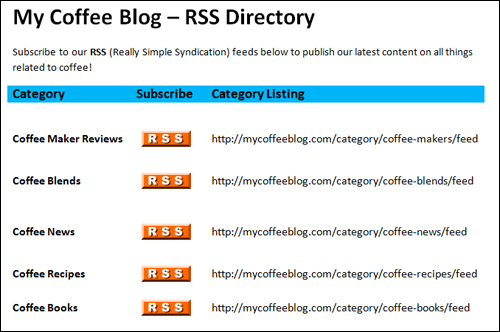
(Set Up A Feeds List)
All you need to do is link a button graphic like the one shown below to category feeds and then create a table or a list of all feeds on a new page …

(RSS button graphic. Image: http://www.public-domain-photos.com/free-cliparts/computer/other/rss_button_roman_bertle_01-2522.htm)
To learn more about creating tables in WordPress content, go here:
RSS Feeds – Notes
You can customize your RSS in various different ways, such as adding videos and images to feeds, ads, etc. Some of these feed customizations require editing code.
WordPress allows several feed configurations without messing with code. Below are examples of some of the kinds of feeds you can display …
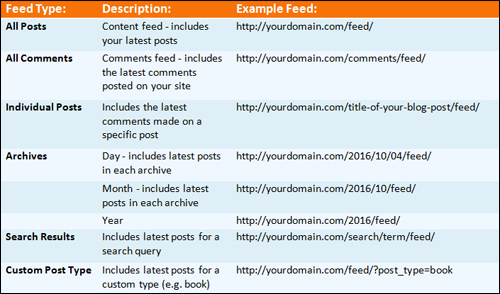
(WordPress RSS – Feed Types)
Below are the feed types, descriptions, and feed examples listed in the diagram above:
- Feed Type: All Posts
- Description: Content feed – Includes your latest posts
- Example Feed: http://yourdomain.com/feed/
- Feed Type: All Comments
- Description: Comments feed – Contains the latest comments posted on your blog
- Example Feed: http://yourdomain.com/comments/feed/
- Feed Type: Individual Posts
- Description: RSS feed containing a post
- Example Feed: http://yourdomain.com/post-title/feed/
- Feed Type: Individual Posts Comments
- Description: Feed that displays the latest comments made on a post
- Example Feed: http://yourdomain.com/blog-post-title/feed/
- Feed Type: Archives
- Description: Day – Displays latest entries in each archive
- Example Feed: http://yourdomain.com/2011/01/22/feed/
- Feed Type: Archives
- Description: Month – Includes the latest items in each archive
- Example Feed: http://yourdomain.com/2016/11/feed/
- Feed Type: Archives
- Description: Year – Contains latest entries in each archive
- Example Feed: http://yourdomain.com/2012/feed/
- Feed Type: Search Results
- Description: Feed that contains latest posts for a search query
- Example Feed: http://yourdomain.com/search/term/feed/
- Feed Type: Custom Post Type
- Description: Displays latest post entries for a custom type (e.g. book)
- Example Feed: http://yourdomain.com/feed/?post_type=book
One last thing …
Remember to let your visitors know that they can subscribe to your RSS feed. Make sure you place your ’subscribe to RSS’ button in a visible location …
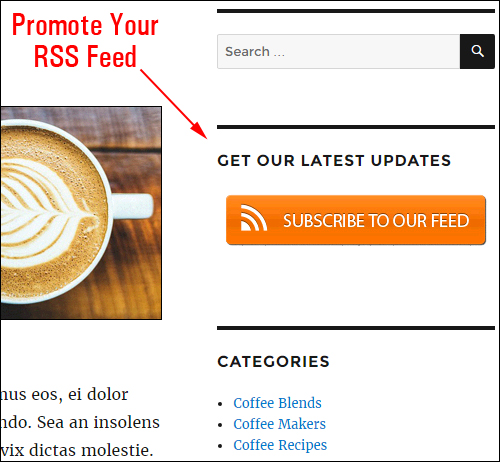
(Remember to promote your RSS feeds!)
Keep in mind that online users will only want to syndicate your content if you publish useful information. In other words, focus on providing your subscribers with high-quality information that can add great value to their sites and benefit their visitors.
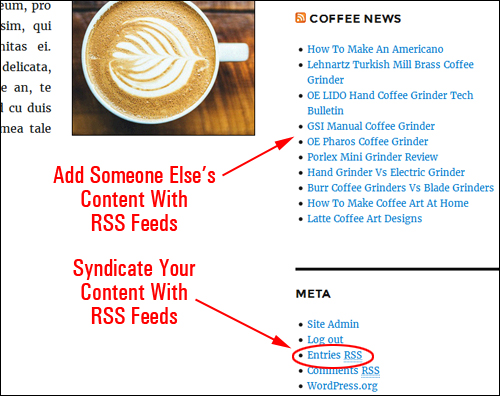
(Add content to your site and get other sites to syndicate your content using WordPress and RSS!)
![]()
If you need help coming up with content ideas subscribe to our FREE content creation course using the form below:
Also, don’t forget to subscribe to our RSS feed 🙂
Resources:
- Download RSS Feed Icons – Visit sites like Feedicons.com or search online (e.g. “free rss icons”, “rss images”, etc.) for sites containing downloadable RSS graphic elements.
- RSSBoard.org – The RSS Advisory Board Go here if you want to gain a better understanding of RSS.
- Wikipedia.org/RSS – General information about RSS.
- WordPress Codex – WordPress documentation repository. Visit this site to learn more about feeds in WordPress.
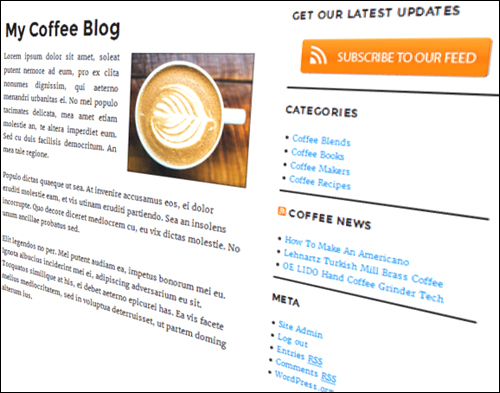
Congratulations! Now you know where to find your WordPress RSS feed, how to syndicate your content online using RSS feeds, and how to add content from other sites to your site using RSS.
Hopefully, this article has given you a better understanding of issues that can affect your website and how WordPress can help you build a better business online. To learn more about the benefits of using WordPress please click on links to visit our related posts section.
***
"Wow! I never knew there's so much to learn about WordPress! I bought one of the WordPress for Dummies three years ago, such authors need to be on this course!" - Rich Law, Create A Blog Now






